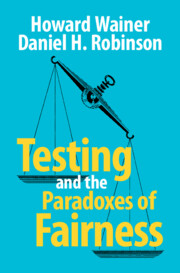Book contents
- Testing and the Paradoxes of Fairness
- Reviews
- Testing and the Paradoxes of Fairness
- Copyright page
- Dedication
- Annotated Table of Contents
- Preface
- Acknowledgments
- Chapter 1 A Brief Recounting of the First Four Millennia of Testing
- Chapter 2 Why Tests Are so Widely Disliked
- Chapter 3 The Origins and Consequences of Mental Testing in the U.S. Military
- Chapter 4 Testing in Grades K-12
- Chapter 5 Licensing Examinations
- Chapter 6 Admission Testing for Higher Education
- Chapter 7 Tests Used for Merit-Based Scholarships
- Chapter 8 Using Student Test Scores to Evaluate Teachers: An Assessment of Value-Added Models
- Chapter 9 Dividing Test Scores into Subcomponents
- Chapter 10 On Cost Functions in Testing
- Chapter 11 Evidence in Science: Should We Use Data and What Data Can We Trust?
- Chapter 12 Three Cautionary Tales of Zombie Ideas about Testing
- Chapter 13 Coda
- References
- Index
Chapter 7 - Tests Used for Merit-Based Scholarships
Published online by Cambridge University Press: 10 October 2025
- Testing and the Paradoxes of Fairness
- Reviews
- Testing and the Paradoxes of Fairness
- Copyright page
- Dedication
- Annotated Table of Contents
- Preface
- Acknowledgments
- Chapter 1 A Brief Recounting of the First Four Millennia of Testing
- Chapter 2 Why Tests Are so Widely Disliked
- Chapter 3 The Origins and Consequences of Mental Testing in the U.S. Military
- Chapter 4 Testing in Grades K-12
- Chapter 5 Licensing Examinations
- Chapter 6 Admission Testing for Higher Education
- Chapter 7 Tests Used for Merit-Based Scholarships
- Chapter 8 Using Student Test Scores to Evaluate Teachers: An Assessment of Value-Added Models
- Chapter 9 Dividing Test Scores into Subcomponents
- Chapter 10 On Cost Functions in Testing
- Chapter 11 Evidence in Science: Should We Use Data and What Data Can We Trust?
- Chapter 12 Three Cautionary Tales of Zombie Ideas about Testing
- Chapter 13 Coda
- References
- Index
Summary
In both K-12 and higher education, it is common to use test scores in deciding which students receive scholarships and other awards. As with placement decisions, this practice is also controversial due to issues of equity. We discuss the evidence supporting test scores as an aid in making such decisions including the costs of finding suitable winners, the costs of false positives, and the costs of false negatives. The G.I. Bill and United Negro College Fund provided scholarships for soldiers returning from World War II. Athletic scholarships have been around since 1952 and show an incredible disparity by race, favoring Black students. In 1955, the National Merit Scholarship (NMS) program was created to support students. The award is not much financially (~$2,500) but other sources of support usually follow students who score high enough to warrant merit. Like other tests, the PSAT/NMSQT shows race differences. States have addressed this differently, with some ranking students by district or school rather by state, resulting in more minorities receiving awards. Evidence suggests that such rankings within schools rather than statewide result in students with lower scores receiving awards but not doing as well academically as others who score higher and yet do not receive awards. Issues of fairness in testing remain.
Information
- Type
- Chapter
- Information
- Testing and the Paradoxes of Fairness , pp. 82 - 89Publisher: Cambridge University PressPrint publication year: 2025
Accessibility standard: Inaccessible, or known limited accessibility
Why this information is here
This section outlines the accessibility features of this content - including support for screen readers, full keyboard navigation and high-contrast display options. This may not be relevant for you.Accessibility Information
Content Navigation
Allows you to navigate directly to chapters, sections, or non‐text items through a linked table of contents, reducing the need for extensive scrolling.
Provides an interactive index, letting you go straight to where a term or subject appears in the text without manual searching.
Reading Order & Textual Equivalents
You will encounter all content (including footnotes, captions, etc.) in a clear, sequential flow, making it easier to follow with assistive tools like screen readers.
You get concise descriptions (for images, charts, or media clips), ensuring you do not miss crucial information when visual or audio elements are not accessible.
You get more than just short alt text: you have comprehensive text equivalents, transcripts, captions, or audio descriptions for substantial non‐text content, which is especially helpful for complex visuals or multimedia.
Visual Accessibility
You will still understand key ideas or prompts without relying solely on colour, which is especially helpful if you have colour vision deficiencies.
You benefit from high‐contrast text, which improves legibility if you have low vision or if you are reading in less‐than‐ideal lighting conditions.
